- Screen Colours:
- Normal
- Black & Yellow
January 2021 Newsletter from Geoff and Mary Knight
The arrival of the Newsletter, more often and excellently printed and produced has been one of the features of our restricted lives this late year.
We both send you and your team our thanks. Other features have been courses and communication over the internet – good for languages, geology and science but rather more limited for singing ensemble.
Along with the possible walking and cycling has come a sense of consideration and neighbourliness. If all these could continue we might more readily bear our privations.
from Jenny and Peter Moxon
… Also, we very much appreciate the work the committee continues to do to keep us in touch with all things Ipswich through the Newsletters and enclosures. Loved the booklet on artworks around the town.
from Jan Parry, Mayor of Ipswich
What an interesting and uplifting read as ever and thank you for your kind acknowledgement!
… Thank you again and best wishes to you and everyone at our wonderful Ipswich Society, your colleagues, contributors and members. It is a real honour to be your President and I very much appreciate the marvellous range and quality of the expertise and experience of the work of the Society, always reflected so well within the Newsletter.
from Graham Day
I was pleased to receive the January edition of the Newsletter, a wonderful and interesting read from cover to cover. Further information in both letters and the article on sculptures/public art in Ipswich is most welcome, as I was unaware of some of it. It makes me wonder why it does not have a higher profile in the promotion of the town to visitors as it must be one of the most interesting and diverse collections in the country. Many sculpture parks would, I believe, be pleased to have such an abundance of riches. Perhaps sculptor Anthony Gormley should be encouraged to place one of his pieces here rather than elsewhere on the Suffolk coast, as he would then realise the opportunity he is missing!
The inclusion of the much-needed book on public art was a masterstroke. A premier publication from a premier Society.
John Barbrook’s article brought back my memories of growing up Over Stoke and attending Luther Road School in 1955. My father had an allotment at Maidenhall and we too had chickens, kept in the back garden: a continuation of war years survival.
The Nursey family of artists was new to me, as was the link between Claude Nursey and the Pre-Raphaelite painter William Holman Hunt – a member of an art movement in which I have always had a great interest.
Ipswich rocks was an excellent title, but made me think of the need to recognise some of the iconic music and other venues which have disappeared. Norwich managed to do it with a paucity of information! A perennial theme of mine over many years, I am afraid to say.
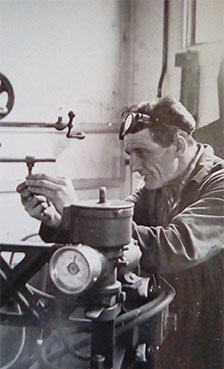 Finally, I was exceptionally pleased to see the letters from Michael Lumb and Kevin Smith on Eduardo Paolozzi. I am extremely grateful to my friend Kevin for providing some further details of his father Len’s work with Eduardo. It put further flesh on the skeleton of my article, the story of a unique collaboration which needs to be told.
Finally, I was exceptionally pleased to see the letters from Michael Lumb and Kevin Smith on Eduardo Paolozzi. I am extremely grateful to my friend Kevin for providing some further details of his father Len’s work with Eduardo. It put further flesh on the skeleton of my article, the story of a unique collaboration which needs to be told.
Photograph from Kevin Smith of metalworker Len Smith.
Street. Scene: I note from the press that work is due to commence later this year on a new primary school and nursery on the former historic Co-op site in Carr Street. Inevitably, the existing buildings will be swept away. Consideration of incorporating the ‘locally listed’ facade was considered, but it was felt that it would ‘significantly compromise the functionality of the new building, would not make best use of the site,and would impact upon the learning experience of attending puplls’. ‘Functionality’ to me implies a utilitarian square design, such as at Stowmarket and Chantry – from working in the latter, it was utterly soulless. I would hope for much much better on a prominent town centre site.
I am not sure how the Co-op logo, mosaic and ‘All for one & one for all’ sign will be incorporated in the new building. What is important is that they are – and are not lost or irrevocably destroyed. The founding fathers of the Co-operative movement in Ipswich would not have been pleased at all, given the impact the local Society had on the Ipswich area for many generations.
Station art work (and more) from Merv Russen
We enjoyed this edition of the Newsletter greatly – it was packed with information and we greatly appreciated the two supplements which were excellent.
I have additional comments regarding the section at the end of the Public Art in Ipswich guide. It is headed ‘Missing Works’ and includes a comment on the engraved perspex tribute to Peter Bruff by Alex Potter in Ipswich Station booking hall. I have kept an eye on this piece over the years.
I spoke to station staff whilst the internal rebuild was taking place in 2017 and I asked if the Bruff panel was to be re-installed. They told me that the work would not be included in the new design and had been returned to the artist’s studio.
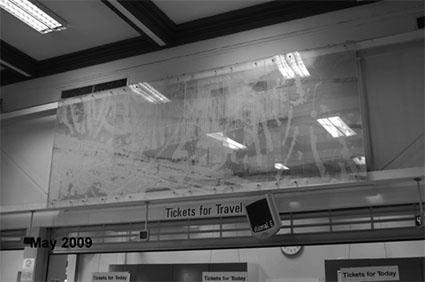 I also thank Mr Lightfoot for providing the Eastern Counties Railway (ECR) rule book which is a fascinating document and is of its time. The ECR only made it to Colchester by the date of that book and it was Cobbold and Bruff’s Eastern Union Railway (EUR) which eventually laid a line to Ipswich.
I also thank Mr Lightfoot for providing the Eastern Counties Railway (ECR) rule book which is a fascinating document and is of its time. The ECR only made it to Colchester by the date of that book and it was Cobbold and Bruff’s Eastern Union Railway (EUR) which eventually laid a line to Ipswich.
Photograph: The engraving was still in place in May 2009 but the fibre optic lights had disappeared. It was positioned on the wall above the booking window and not on the ceiling as described in your brochure. By 2011 it was covered over by an Ipswich Town advertising panel. (See the second photograph.)
Interestingly, there was no love lost between the two railways and originally, they intended to have two separate stations at Colchester. Passengers from London would have had to change train at Colchester, including a walk to the Eastern Union Railway station. Luckily, common sense prevailed and eventually a single station was built. The ECR eventually absorbed the EUR in 1854 and all became part of the Great Eastern Railway in 1862.
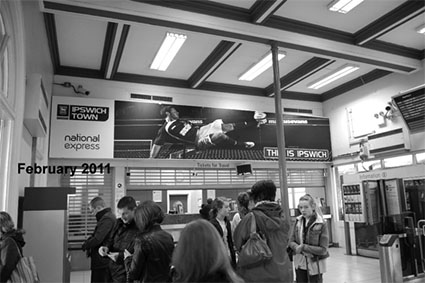 It was also interesting to see the signalling used at that time. The railway policemen had the job of signalling by hand to approaching trains. There is a watercolour picture, drawn by Fred Russel, in the Colchester and Ipswich Museum collection, showing a policeman giving the ‘all clear’ using hand signals to a locomotive. The latter is exiting the proposed southern portal of Stoke Hill tunnel in Ipswich. Pictured behind him is a small shelter for him to stand in if it rained. This could be considered as a precursor to the later signal box!
It was also interesting to see the signalling used at that time. The railway policemen had the job of signalling by hand to approaching trains. There is a watercolour picture, drawn by Fred Russel, in the Colchester and Ipswich Museum collection, showing a policeman giving the ‘all clear’ using hand signals to a locomotive. The latter is exiting the proposed southern portal of Stoke Hill tunnel in Ipswich. Pictured behind him is a small shelter for him to stand in if it rained. This could be considered as a precursor to the later signal box!
Thank you, Robin Gaylard, John Norman and all those who were involved in producing these excellent publications. You brighten these difficult times we live in.
Public Art in Ipswich – missing works from Douglas Seaton
The interesting focus on sculptures and other items of public art in January’s Newsletter and the illustrated pamphlet on the same subject mentioned a list of missing works. Among those missing works the late Dev Mukerji’s impressive life-size bull, that used to stand close to the Wolsey Theatre on Civic Drive, deservedly got a mention – it having been removed after suffering wilful damage.
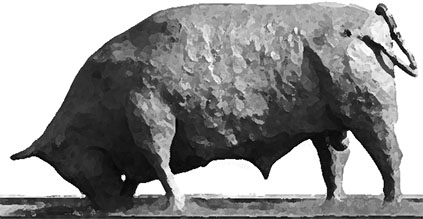
Like your contributor, I always assumed that it had been cast in bronze, as it gave that appearance to the passer-by, but in conversation with Dev after the event, he explained to me that it had been moulded using some form of resin. This accounted for its susceptibility to the attention of apprentice vandals and its subsequent removal. Bronze sculptures are usually sufficiently robust to withstand most assaults unless they have a high centre of gravity in which case they may, of course, be toppled.
A replica statue of Queen Victoria from Martin Talbot
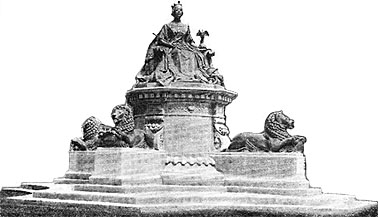 My name is Martin and I was born at 28 Clarkson Street, Ipswich, in July 1945.
My name is Martin and I was born at 28 Clarkson Street, Ipswich, in July 1945.
I was just wondering if anybody has ever looked into the possibility of getting a replica statue of ‘Queen Victoria’, that once stood just inside Christchurch Park, and applying to the council for its erection on the exact site where it once stood? Obviously, it would have to be of a different material than the original.
Also, are there any of the original details of its design and size in existence? If this is at all possible, I would be more than happy to start looking into a ‘Fund Raising Exercise’ to achieve it.
The Chairman replies:
Personally, I wouldn't replace the long lost statue of Queen Victoria, she has no relevance to the town today and I don't think she ever visited the town during her long reign. In my opinion any new statue to be erected in the town should represent the 21st century, its people or their achievements.
Richard Cocke, regarded as the authority on public art nationally, suggests that there are very few 'breeches statues' in Ipswich, we simply haven't erected representations of the great and the good (usually rich white men who held high office, in business or in public life). What we do have is a diverse and dynamic range of quality public art, from the ever lovable 'Grandma' to 'Formation' at the entrance to Ravenswood. Richard's book The public sculpture of Norfolk and Suffolk is enlightening, comparing Ipswich with Norwich whilst noting that there are very few statues in Bury.
If we were, as a community, to erect a statue to a monarch (and I, for one, hope we don't), we should start fund-raising now for the inevitable and commemorate this country's longest reigning queen. The subject does however make for a great debate. John Norman
The Society's booklet Public art in Ipswich can be downloaded from this website.